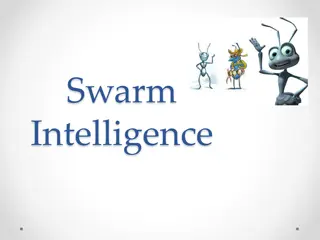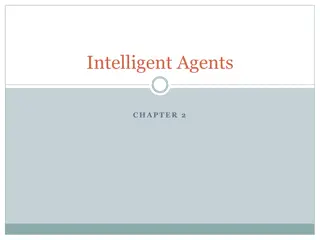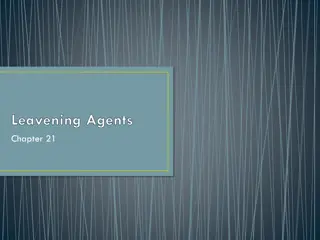Traffic Optimization for Self-interested and Compliant Agents
In this study, Guni Sharon, Michael Albert, Tarun Rambha, Stephen Boyles, and Peter Stone explore traffic optimization for a mixture of self-interested and compliant agents. The research delves into routing flows of agents across networks and analyzes equilibrium scenarios. The motivation behind the study is to address challenges in influencing self-interested agents due to limited resources. The problem definition involves determining the minimal set of agents required to achieve optimal flow in the network. The research also discusses related work on equilibrium scenarios in mixed user equilibrium and Cournot-Nash scenarios.
Download Presentation

Please find below an Image/Link to download the presentation.
The content on the website is provided AS IS for your information and personal use only. It may not be sold, licensed, or shared on other websites without obtaining consent from the author. Download presentation by click this link. If you encounter any issues during the download, it is possible that the publisher has removed the file from their server.
E N D
Presentation Transcript
Traffic Optimization For a Mixture of Self-interested and Compliant Agents Guni Sharon, Michael Albert, Tarun Rambha, Stephen Boyles and Peter Stone
Overview Route a flow of agents across a network S T
Overview Route a flow of agents across a network Self interested routing user equilibrium S T
Overview Route a flow of agents across a network Self interested routing user equilibrium System optimum routing optimal flow S T Least marginal cost path
Overview Route a flow of agents across a network Self interested routing user equilibrium System optimum routing optimal flow Mixed, SO-UE scenario ? ? S T
Mixed UE-SO equilibrium Mixed scenario is a Stackelberg game SO agents are the leaders UE agents are the followers S T UE SO
Motivation Influencing self interested agents is expensive A system manager usually has limited resources
Problem definition Given: A network ? A set of latency functions non-negative, differentiable, non-decreasing, convex The demand for each source target pair Return: The minimal set of SO agents that is required in order to achieve SO flow? 1 9 : 12 agents 5 12 : 4 agents ? ? : ? agents
Related work Equilibrium for a mixed UE, Cournot-Nash (CN) scenario Unique, can be computed using a convex program (Haurie and Marcotte 1985; Yang and Zhang 2008) Equilibrium for a mixed UE, SO scenario with common source and a common target and any number of parallel links Korilis et. al. (1997) NP-hard in the general case (Roughgarden 2004) S T
Example problem ??? = the latency on link ? as a function of the assigned flow Assume demand: 1 3 : 1 + 2/3 3 5 : 1 + 2 4 : 1 Else : 0 2/3
System optimum What routes would a self interested agent consider?
System optimum What routes would a self interested agent consider? The least latency routes! 1 3 : ?1 3 5 : ?2 2 4 : ?3 ?4
Self interested sub-flow Self interested flow may be assigned only to least latency path Self interested flow may not exceed the flow at SO Run max-flow under these constraint and the original demand o = 1 + 2 2/3
Self interested sub-flow Self interested flow may be assigned only to lease latency path Self interested flow may not exceed the flow at SO Run max-flow under these constraint and the original demand o = 1 + 2 2/3 Wrong! We are missing a constraint
Missing a constraint The previous solution assigns a flow of 1 to the dashed link At SO no flow originating from 1 or 3 may travel the dotted line At SO no flow originating from 2 may travel the dotted line
Another necessary constraint Self-interested flow must follow SO paths Paths with least marginal cost Run max-flow under these constraint and the original demand o = 2 2/3
LP formalization 1. Maximize the self-interested flow over all source-target pairs Self interested flow may not exceed original demand Flow originate at source Flow preservation constraint Self-interested flow may not exceed flow at SO solution No negative flow or demand Positive flow is assigned only to paths with minimal latency and minimal marginal cost 2. 3. 4. 5. 6. 7.
Experimental results Six benchmark traffic scenarios, available at: https://github.com/bstabler/ Smaller networks can tolerate more self-interested agents at SO Larger networks -> less zero reduced paths -> less self-interested agents Scenario Vertices Links Total demand UE TTT SO TTT % improvement % self-interested Sioux Falls 24 76 360,600 7,480,225 7,194,256 3.82 86.96 Eastern MA 74 258 65,576 28,181 27,323 3.04 80.27 Anaheim 416 914 104,694 1,419,913 1,395,015 1.75 80.24 Chicago 933 2,950 1,260,907 18,377,329 17,953,267 2.31 72.71 Philadelphia 13,389 40,003 18,503,872 335,647,106 324,268,465 3.39 50.41 Chicago regional 12,982 39,018 1,360,427 33,656,964 31,942,956 5.09 46.66
Take home Achieving optimal traffic flow might not require controlling all agents The paper presents a tractable LP for computing the maximal volume of self-interested agents that a system can tolerate at SO The LP solution identifies the set of required SO agents The paper also provides answers to the following: 1. What routes should be assigned to the SO agents? 2. Is a given set of SO agents sufficient for achieving SO flow?























